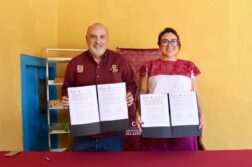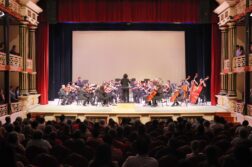Everything from nogada ice cream to Cholula-style grasshoppers offered over next 2 weekends

The 12th Feria de la Nuez de Castilla in San Pedro Yancuitlalpan, Puebla — a fair celebrating traditional food found in and around San Pedro that opened this past weekend and runs for two more — is definitely not a place to go if you’re on a diet. But it’s a great place to eat some excellent cuisine from the state — and not just chile en nogada, one of the state’s signature dishes.
About 20 stands are set up on the grounds of the Church of the Immaculata Concepción (which was probably built atop a pre-Hispanic pyramid). The majority are found in the lower area of the church grounds and all of the stands located there are serving one of the dishes the region is famous for.
“Chile en nogada is the main dish served here, and the most popular,” said Ana Maria Sandie Trifundio, who organized this year’s fair and has her own stand. “It is because the people from San Pedro produce all the ingredients.”
Chile en nogada is a poblano chile stuffed with fruits, nuts and, typically, pork. It’s then covered with a delicious white sauce made with walnuts, queso fresco (farmer’s cheese) and queso Filadelfia (Philadelphia cream cheese) that’s thinned with a little milk and topped with a sprig of parsley and some pomegranate seeds, giving the dish the colors of the Mexican flag.
Although chile en nogada can now be found all across Mexico, it’s most closely associated with Puebla and with August and September, when the ingredients needed to make it are being harvested.

But the vendors set up directly in front of the church go beyond chile en nogada.
Filomena Amozoqueño has been selling her food at the fair for 10 years, serving up bean tamales, nopal salad and rice as well as mole rojo and mole verde. Salsa de chito — a salsa she makes by hand using tomatoes, guajillo chile and garlic, to which she adds some dried goat meat — is one of her specialties, she said. “This fair is important because it preserves our tradition,” she said, “and also helps us economically.”
Across the plaza from Amozoqueño’s stand is Antojitos Doña Ade, where owner Adela González can be found presiding over a Mexican skillet called a comal. She’s a traditionalist when it comes to preparing food. “Everything is made by hand,” she said. “We are accustomed to making things by hand, and the food has a better flavor.”
She makes memelas, thick corn tortillas that she toasts on the comal and covers with beans and salsa. There’s also an interesting, and extremely tasty, tostada made with blue corn, which has requesón (a ricotta-like cheese), crema, avocado and pomegranate seeds — another nod to the Mexican flag. “We only use food that is produced here,” she added proudly. “Even the requesón is made here.”
For the more adventurous, her food can be topped with chapulines: roasted grasshoppers. According to a sign hanging above her stand, chapulin is a Náhuatl word meaning “insects that jump like a rubber ball.” Grasshoppers are rich in several vitamins and minerals and a good source of protein.
“I was sent an invitation,” said Maria de Socorro Tlapa of Cholula, who trained as a chef and is the owner of Yuyu Cupcakes there. She was enjoying González’s food with her brother, Alejandro Tlapa, including the grasshoppers. “I like that the food is continuing the tradition in the area,” she said. “Here, I like the tostada with chapulines. Chapulines are crunchy but soft, a little spicy and acidic because lime is added.”
After enjoying some of the cuisine, strolling around the grounds a bit and perusing what non-edible items are available is a good way to make room for dessert. Marcelina Gómez Analco’s stand features jewelry she makes from beans, nuts, peach pits and acorns.
“I make these,” she said, “so people can buy something that will remind them of the pueblo.”
Nearby, Lidia Temich Cantero was selling objects made from a pine tree called Ocote Moctezuma, a tree whose needles are very long. “I collect the material that has fallen on the ground,” Temich explained. “[I] wash it and dry it well. I can then make things from it.”
The earrings and hair barrettes she sells take her about half an hour to make, while larger items like a small bag will take her about a week.
Yeni Popoca Fernández has an ice cream stand on one side of the church where she sells helado de nogada.

This dish is vanilla ice cream with walnuts, apples, peaches and pears. She tops it with crema de salsa nogada (a sauce made from walnuts), pomegranate seeds and a sprig of parsley — these seem to be required at the fair — and serves it in a corn husk.
Martha Cabrera sat nearby, greatly enjoying the dessert. “The helado en nogada has a good flavor, and I liked the concept of using corn husks instead of plastic plates,” she said. “I also like that it is decorated like chile en nogada.”
Another stand has buñuelos — large fried dough that can be topped with sugar or honey. Or both, if desired.
The annual fair, said Sandie, is an opportunity for the pueblo to highlight and share its traditional foods.
“We do this to rescue our roots and the origins of the pueblo, to rescue pre-Hispanic foods,” she said. “We have food like … cacamas [beans], yelo tlachchal [a tortilla made with corn and honey], tlapextumal [a flat tamale with mole verde]and salsa made by hand. This is food that is healthy and flavorful.”
San Pedro, like everywhere in the world, was affected by the virus. Popoca’s family all had Covid-19. “We were in quarantine for 40 days,” she said.
Despite that, she’s at the fair. “I am nervous. Everybody is. But we have to work. We have to pay for everything. It is like I say, ‘If I stay home, I die from hunger. If I go out, I die from Covid.’”
She wore a mask, something that’s required to enter the grounds, and used sanitizing gel liberally, as did all of the fair’s participants. The fair is held outdoors to lessen any chance of transmission.
The event runs for two more weekends — on August 21–22 and on August 28–29. It opens around 11:00 and closes when, as participating cook Sandra Popoca Ochoa said, there are no more people to serve. Or, as Amozoqueño put it, “Hasta que el cuerpo aguante” (as long as the body allows).
A heads-up: one of the invitations sent out to this event — the one that de Socorro had — says that San Pedro is a 20-minute drive from Cholula. Unless you’re driving even faster than most people in Mexico, it’s actually about 45 minutes. But it’s worth a trip, however long it takes.
• More information about the fair can be found on its Facebook page.
Joseph Sorrentino, a writer, photographer and author of the book San Gregorio Atlapulco: Cosmvisiones and of Stinky Island Tales: Some Stories from an Italian-American Childhood, is a regular contributor to Mexico News Daily. More examples of his photographs and links to other articles may be found at www.sorrentinophotography.com He currently lives in Chipilo, Puebla.



